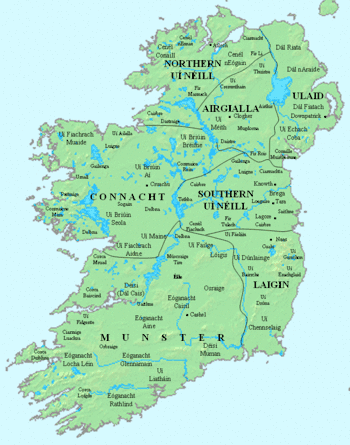Conmhaícne
The Conmhaícne or Conmaicne were an people of early Ireland, perhaps related to the Laigin, who dispersed to various parts of Ireland. They settled in Connacht and Longford, giving their name to several Conmaicne territories. T. F. O'Rahilly's assertion the Conmaicne were non-Goidelic is not widely accepted.[1]

Etymology
Their name supposedly originates from a mythical ancestor known as Conmac, descended from Fergus mac Roich and Queen Maeve of Connacht. However Walsh stated "Conmac son of Fergus is a genealogical fiction".[2] The word Conmacne means "progeny of Conmac" (ne, a progeny). Conmac itself means "hound-son" (con, hound; mac, son).
Branches
Branches of the Conmaicne dispersed to various places.
Conmaicne na Gaillimhe
- Conmhaícne Mara (Conmaicne of the sea) settled in the west of County Galway, in the territory of Conmhaícne Mara, anglised today as Connemara.
- Conmhaícne Dúna Móir, or Conmaicne Cenel Dubáin, at Dunmore, County Galway.
- Conmhaícne Mhean or Conmaicne Máenmaige (Conmaicne of the central plain), Loughrea, County Galway.
Conmaicne Mhaigh Eo
- Conmhaícne Cúile, of Kilmaine, County Mayo
- Conmhaícne Ceara, of Carra, County Mayo.
- Conmaicne Meic Oirbsen Máir near Lough Corrib, County Mayo
Conmaicne Ros Comáin
- Conmhaícne Sléibe Formaile, near Ballinlough, in west County Roscommon.
Conmaicne Rein
- Conmhaícne Rein, or "lower conmaicne", of south County Leitrim into County Longford.
- Conmhaícne Angaile, or "upper Conmaicne", now county Longford.[3]
The Diocese of Ardagh was established in 1111 as the see for east Connacht. Fourteen years later, at the Synod of Kells-Mellifont, its area was reduced to the territory of the Conmaicne Rein and Conmaicne Angalie, south county Leitrim and all county Longford.[4] The diocese was commonly called "the Diocese of the Conmaicne".
Septs
Known Septs of the Conmhaícne Rein in south County Leitrim were:
- Conmhaícne Maigh Rein anglicised today as barony of Mohill.
- Cluain Conmhaícne (Conmaicne of the pasture) of Cloone parish, in Carrigallen and Mohill barony.
- Conmhaícne Cenel Luacháin (Conmaicne descended from Luchan), both Oughteragh and Drumreilly parishes at Carrigallen, County Leitrim.
- Conmaicne Maigh Nissi along the Shannon, anglicised today as barony of Leitrim.
People
John O'Donovan wrote:
The chief familes of the Conmacians were the O'Fearralls, princes and lords of Annaly, or Longford; the Mac rannalls, a name anglicised to Reynolds, who were Lords of Conmaincee of Moy-Rein and Muintir-Eolais, in Leitrim; the Mac Keoghes, who were chiefs in Galway, and also in Lenister; the MacShanleys; O'Rodaghans; MacDorchys; O'Mulveys; O'Morans, and O'Mannings, chiefs and clans in various parts of Longford, Leitrim, and Roscommon.[5]
Notables descended from the Conmhaicne include Cruimthear Mac Carthaigh, St. Jarlath of Tuam and some abbots of Clonmacnoise.
References
- MacKillop 2004.
- Walsh 1940, p. 6.
- AFM.
- P Galloway, The Cathedrals of Ireland, Belfast, 1992
- AFM & p417.
- Some Connacht Population-Groups, Nollaig Ó Muraíle, in Seanchas:Studies in Early and Medieval Archaeology, History and Literature in Honour of Francis John Byrne, pp. 176–76, Four Courts Press, Dublin, 2000
- Medieval Ireland: Territorial, Political and Economic Divisions, Paul Mac Cotter, Four Courts Press, 2008, pp. 134–135. ISBN 978-1-84682-098-4
Secondary sources
- Annals of the Four Masters, ed. & tr. John O'Donovan (1856). Annála Rioghachta Éireann. Annals of the Kingdom of Ireland by the Four Masters... with a Translation and Copious Notes. 7 vols (2nd ed.). Dublin: Royal Irish Academy. CELT editions. Full scans at Internet Archive: Vol. 1; Vol. 2; Vol. 3; Vol. 4; Vol. 5; Vol. 6; Indices.
- MacKillop, James (2004). "Conmaicne. Oxford Reference.". A Dictionary of Celtic Mythology. Oxford University Press.CS1 maint: ref=harv (link)
- Walsh, Paul (1940). "Connacht in the Book of Rights". Journal of the Galway Archaeological and Historical Society. Galway Archaeological & Historical Society. XIX, Nos. i & ii, 19 (1/2): 1–15. JSTOR 25535199.CS1 maint: ref=harv (link)